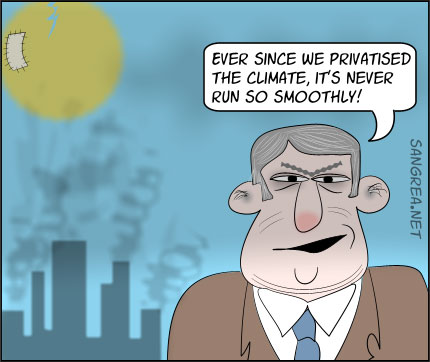2012 SkS Weekly Digest #18
Posted on 7 May 2012 by John Hartz
SkS Highlights
In the second installment of the Why Are We Sure We're Right? series, SkS authors Rob Honeycutt, Dana Nuccitelli, and Andy S. explain why they embrace what mainstream scientists are telling us about climate change. Needless to say, this post generated the highest number of comments during the week. Coming in second and third respectively were Dana's John Nielsen-Gammon Comments on Continued Global Warming and John Mason's Two Centuries of Climate Science: part two - Hulburt to Keeling, 1931- 1965.
Toon of the Week

Another climate change solution
Source: Royalty Free Cartoons
Quote of the week
“The big damages come if the climate sensitivity to greenhouse gases turns out to be high,” said Raymond T. Pierrehumbert, a climate scientist at the University of Chicago. “Then it’s not a bullet headed at us, but a thermonuclear warhead.”
Source: "Clouds’ Effect on Climate Change Is Last Bastion for Dissenters" by Justin Gillis, New York times, Apr 30, 2012
Issue of the Week
When it comes to manmade climate change, what do you consider to be the most significant "canary in the coal mine"?
Words of the Week
Greenhouse effect Greenhouse gases effectively absorb thermal infrared radiation, emitted by the Earth’s surface, by the atmosphere itself due to the same gases, and by clouds. Atmospheric radiation is emitted to all sides, including downward to the Earth’s surface. Thus, greenhouse gases trap heat within the surface-troposphere system. This is called the greenhouse effect. Thermal infrared radiation in the troposphere is strongly coupled to the temperature of the atmosphere at the altitude at which it is emitted. In the troposphere, the temperature generally decreases with height. Effectively, infrared radiation emitted to space originates from an altitude with a temperature of, on average, –19°C, in balance with the net incoming solar radiation, whereas the Earth’s surface is kept at a much higher temperature of, on average, +14°C. An increase in the concentration of greenhouse gases leads to an increased infrared opacity of the atmosphere, and therefore to an effective radiation into space from a higher altitude at a lower temperature. This causes a radiative forcing that leads to an enhancement of the greenhouse effect, the so-called enhanced greenhouse effect.
Greenhouse gas (GHG) Greenhouse gases are those gaseous constituents of the atmosphere, both natural and anthropogenic, that absorb and emit radiation at specific wavelengths within the spectrum of thermal infrared radiation emitted by the Earth’s surface, the atmosphere itself, and by clouds. This property causes the greenhouse effect. Water vapour (H2O), carbon dioxide (CO2), nitrous oxide (N2O), methane (CH4) and ozone (O3) are the primary greenhouse gases in the Earth’s atmosphere. Moreover, there are a number of entirely human-made greenhouse gases in the atmosphere, such as the halocarbons and other chlorine- and bromine-containing substances, dealt with under the Montreal Protocol. Beside CO2, N2O and CH4, the Kyoto Protocol deals with the greenhouse gases sulphur hexafluoride (SF6), hydrofluorocarbons (HFCs) and perfluorocarbons (PFCs).
Source: Annex I (Glossary) to Climate Change 2007: Working Group I: The Physical Science Basis, IPCC Fourth Assessment Report.
The Week in Review
A complete listing of the articles posted on SkS during the past week.
- West Antarctic Ice Shelves Tearing Apart at the Seams by John Hartz
- Report Warns of Rapid Decline in U.S. Earth Observation Capabilities by John Hartz
- rbutr Puts Climate Information In Front of Those Who Need It Most by Shane Greenup
- HadSST3: A detailed look by Kevin C
- Why Are We Sure We're Right? #2 by Rob Honeycutt, Dana Nuccitelli, and Andy S.
- Lessons from Past Predictions: Hansen 1981 by Dana
- Two Centuries of Climate Science: part two - Hulburt to Keeling, 1931- 1965 by John Mason
- New research from last week 17/2012 by by Ari Jokimäki
- John Nielsen-Gammon Comments on Continued Global Warming by Dana
Coming Soon
A list of articles that are in the SkS pipeline. Most of these articles, but not necessarily all, will be posted during the week.
- Lindzen's Clouded Vision, Part 1: Science (Dana)
- New research from last week 18/2012 (Ari Jokimäki)
- Lindzen's Clouded Vision, Part 2: Risk (Dana)
- Turbines in Texas helping to cool the planet? (MarkR)
- Two Centuries of Climate Science: part three - Manabe to the present day, 1966-2012 (John Mason)
- Arctic Winter Analysis (Neven)
- 101 responses to Ian Plimer's climate questions (John Cook)
- Open letter to an anonymous climate scientist (Dumb Scientist)
- In Search Of: Himalayan Ice Loss (mspelto & Daniel Bailey)
- CRUTEM4: A detailed look (Kevin C)
Simple Myth Debunking of the Week
Anyone who argues There is no consensus is denying the many different studies and surveys which demonstrate that approximately 97% of climate scientists agree that humans are the main cause of the current global warming.
SkS Spotlights
The Max Planck Institute for Meteorology (MPI-M), located in Hamburg, Germany, is an internationally renowned institute for climate research. Its mission is to understand Earth's changing climate.
The MPI-M comprises three departments:
and three independent research groups:
Scientists at the MPI-M investigate what determines the sensitivity of the Earth system to perturbations such as the changing composition of its atmosphere, and work toward establishing the sources and limits of predictability within the Earth system. MPI-M develops and analyses sophisticated models of the Earth system, which simulate the processes within atmosphere, land and ocean. Such models have developed into important tools for understanding the behaviour of our climate, and they form the basis for international assessments of climate change. Targeted in-situ measurements and satellite observations complement the model simulations.
Together with several other non-university research institutions the MPI-M and the University of Hamburg constitute the KlimaCampus, a centre of excellence for climate research and education in Hamburg, Germany.































 Arguments
Arguments























 0
0  0
0






Comments